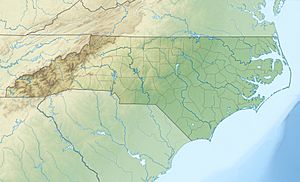Buffalo Creek (Reedy Fork tributary) facts for kids
Quick facts for kids Buffalo Creek |
|
|---|---|
|
Location of Buffalo Creek mouth
|
|
| Other name(s) | Tributary to Reedy Fork |
| Country | United States |
| State | North Carolina |
| County | Guilford |
| Physical characteristics | |
| Main source | confluence of South Buffalo and North Buffalo Creeks about 2 miles north of McLeansville, North Carolina 660 ft (200 m) 36°07′40″N 079°39′44″W / 36.12778°N 79.66222°W |
| River mouth | Reedy Fork about 6 miles south of Osceola, North Carolina 618 ft (188 m) 36°10′27″N 079°36′05″W / 36.17417°N 79.60139°W |
| Length | 8.31 mi (13.37 km) |
| Basin features | |
| Progression | northeast |
| River system | Haw River |
| Basin size | 100.58 square miles (260.5 km2) |
| Tributaries |
|
| Bridges | McLeansville Road, High Rock Road, Huffline Mill Road |
Buffalo Creek is a stream in Guilford County, North Carolina, in the United States. It flows for about 8.31 mi (13.37 km). This creek is a "tributary," meaning it's a smaller stream that flows into a larger one. Buffalo Creek joins the Reedy Fork.
Contents
What is Buffalo Creek?
Buffalo Creek is a natural waterway. It is known as a "4th order" stream. This means it has many smaller streams flowing into it.
Other Names for Buffalo Creek
Sometimes, Buffalo Creek has been called by another name. Historically, it was also known as:
- South Buffalo Creek
Where Does Buffalo Creek Flow?
Buffalo Creek starts in Guilford County, North Carolina. It begins where two smaller streams meet. These are called South Buffalo Creek and North Buffalo Creek. This meeting point is about 2 miles north of McLeansville, North Carolina.
After starting, Buffalo Creek flows towards the northeast. It travels about 6 miles south of Osceola. This is where it meets the Reedy Fork.
The Land Around Buffalo Creek
The area that Buffalo Creek drains is called its "watershed." This watershed covers about 100.58 square miles (260.5 km2) of land.
This area gets a good amount of rain each year. On average, it receives about 45.5 inches of precipitation. About 19% of the land in this watershed is covered by forests.



